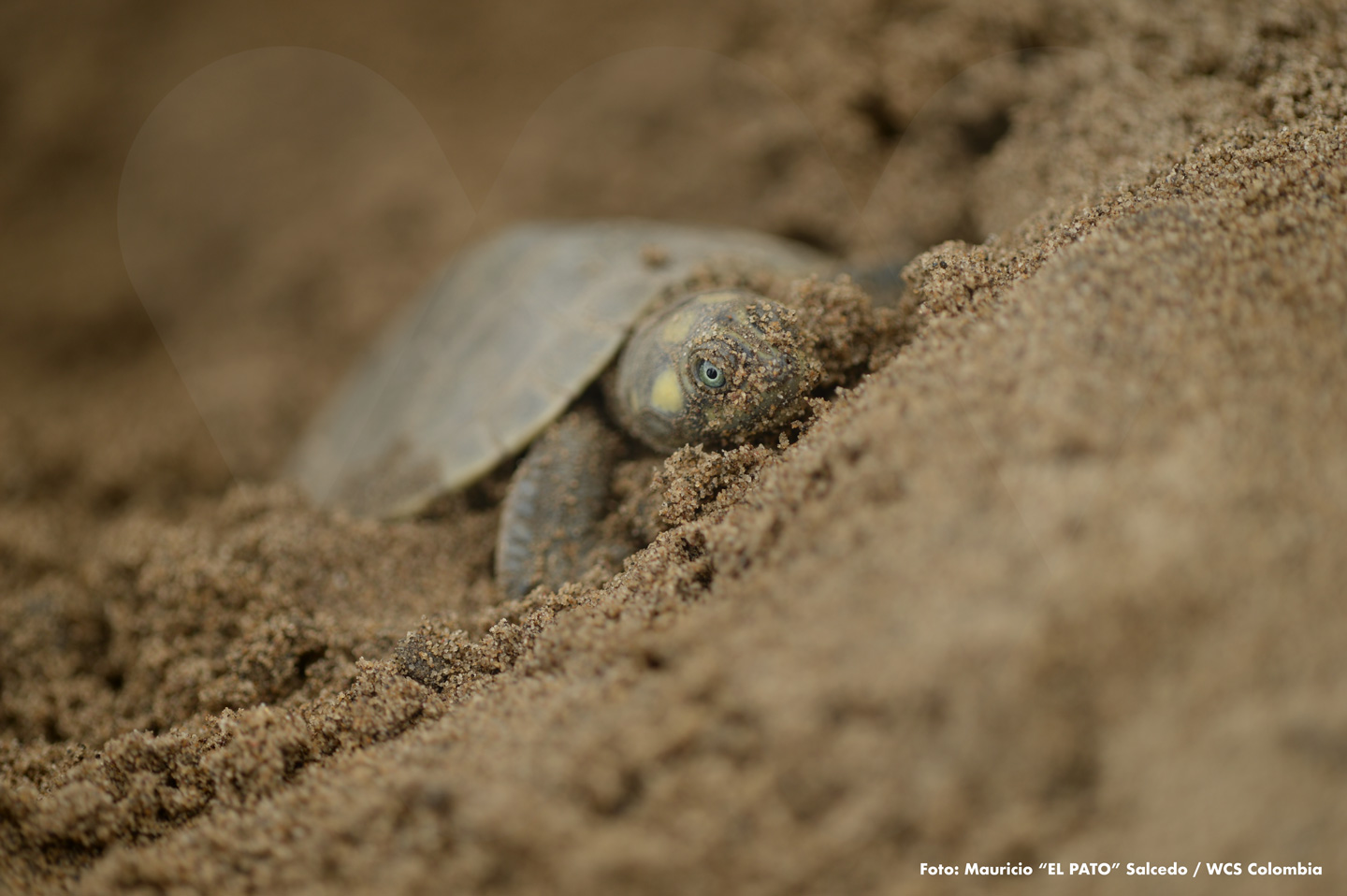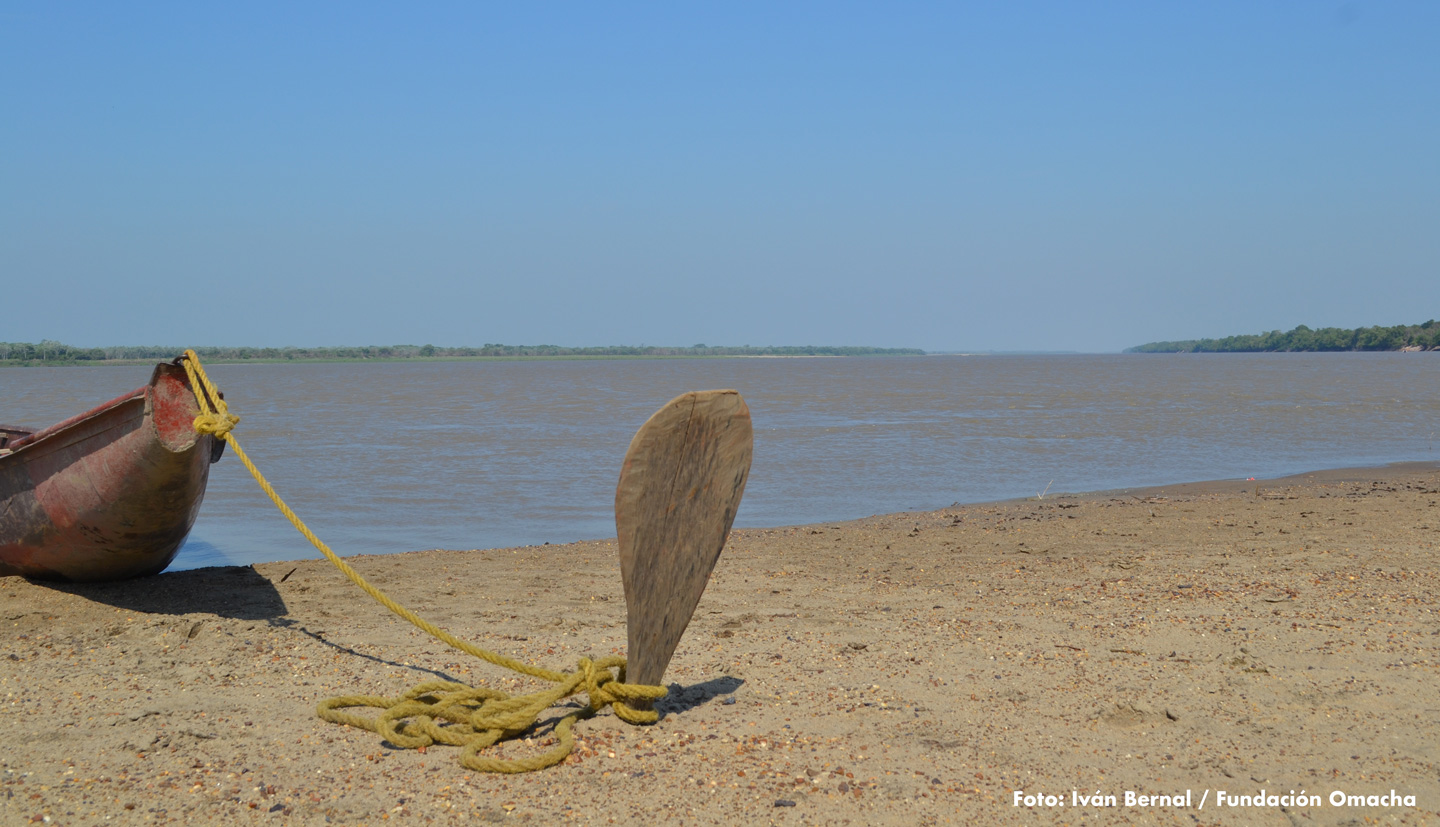By: Mónica Diago
This year, an entire community that voluntarily decided to participate in the protection of the Giant South-American river turtle, a critically endangered species, will be present during its nesting season. This process, which has been overseen by Proyecto Vida Silvestre for seven years, has a new perspective now.

The foster parents of the Giant South-American river turtles guard the Meta River banks at night. They spend the cold nights on air mattresses and get up very early, before the breeze starts and erases the tracks left on the sand by the mother turtles after they deposit their clutches. Almost four months of intense work, of long walks (more than 24 kilometers/15 miles), of notebooks full of information and of many conversations. “Besides all our searches to find the nests, then labelling and registering them, we have to talk with the fishermen and the people coming from other places that we meet in the area. We have to tell them why we are here, why we are the caretakers of the turtles and why it is important to protect them. We hope this will encourage them to cooperate, leaving the eggs and the animals alone”, says Edwar Cuburuco, an inhabitant of the village of Santa María de la Virgen, located in Cravo Norte. Arauca, on the border of the Meta River.
Edwar, born 22 years ago and now dedicated to stockbreeding, has been committed with this program for 3 years. In the previous seasons, he was paid for being a foster parent of the species, but in 2022 he will be one of the several volunteers who will take care of them without any economic compensation in return. Proyecto Vida Silvestre will continue supporting them with the creation of strategies that will contribute to the development and welfare of the community, but their commitment with the conservation of the species will be progressively more autonomous. “When we are born here”, Edwar says, “we sometimes think that turtles are only to eat or that we can take their eggs like those of any other animal. But once we begin to understand all the effort these animals must make, all the challenges they must overcome in order to reach adulthood and their reproductive age, our perception changes”.

Edwar adds that, some time ago, he began to attend talks and workshops on the importance of the South-American river turtle for the balance of nature. Its importance, he says, consists in the transportation of fruits and seeds along the river, with which it contributes to the stability of certain habitats, and in its participation in the food chain. The turtle is food for birds, catfish, foxes, jaguars, caimans and river otters. These and other reasons, that Edwar does not explain, were what “inspired his affection towards those animals. I learned things that I did not know before and realized that our turtle was endangered and it was then that I decided to get involved in its protection. I cannot harm them; they become part of my family”, he concludes.
The conviction with which he speaks is what motivates him to volunteer for this new nesting season of the Giant South-American river turtle. For Proyecto Vida Silvestre, initiative technically led by WCS Colombia for seven years, in partnership with Fundación Omacha, this natural dynamic is of great interest. With direct support from the communities bordering the Meta River (limit between Arauca and Vichada), the project promotes control and surveillance activities of the river borders during the turtles’ nesting season. Project participants support the turtles from the moment they lay their eggs until the eggs hatch and the little turtles look for the river to start their lives, free.

The community, however, will be involved differently during this year’s nesting season. Mara Ibeth Contreras, leader of social processes of the Llanos Orientales landscape, explains. “Approximately 29 families will be involved in the process. Adults will monitor the beaches. Families will plan times and shifts in 3 sectors along a stretch of 40 km of the river. Six people per day will be required for field work and the rest of the community can participate analyzing the information. We will support them in the strengthening of their individual skills and, as community, we will provide some necessary supplies, such as gasoline for the boats, but they will be in charge of the program”, says the expert.
With the new operating system for the care of the turtles, this community has several challenges: dialogues with the fishermen to make them aware of the importance of the conservation of the South-American river turtle, positioning of their strategy to obtain respect from the passersby for this area that they so diligently conserve, contact with municipal authorities to obtain support, especially from institutions responsible for the care of water, rivers and basins and showing the rest of the region that the sustainable use and conservation of the resources given to us by nature are possible.
In this manner, with the community forming a team of volunteers for the care of the South-American river turtle, there will be more benefits for all, says Mara. “It will be a sustainable process as these participants will acquire technical knowledge in the monitoring process and will no longer have to depend on a small group of people skilled in the details of this job. Besides, by strengthening their capacities, they will be able to manage resources and their conservation work will not necessarily have to be bound to a project like Proyecto Visa Silvestre. With this immersion and commitment, the inhabitants of this region will be able to maintain this exercise in the long-run. If the group wants this zone to be declared ‘area of special care for the South-American river turtle', it will have all the grounding and knowledge to obtain it, in favor of the species.
The Giant South-American river turtle, a species generous with our land
Mauricio Correa is a WCS Colombia biologist. He has worked for four years caring for this turtle. He has been by their side, he has slowed down his footsteps to avoid scaring them, he has respected their stride, he has controlled his impatience to sit by their side and see them breathe. “This is a magnificent turtle, it is the biggest river turtle in South America. To get near them, you have to understand them, know how they interact, show them that you want to share the same space, but with respect, because their first reaction when they see a human being near them is to run away.”

Mauricio has seen the spectacle of the nesting of the South-American river turtle many times. “The most active time is between mid-February and the beginning of March. Each one can produce from 40 to 70 eggs, sometimes a bit more. Nights seem like a charge of turtles. They walk over one another and they even take out other mothers’ eggs from a nest, to put in their own. It is a stunning ritual where they, besides having to compete with each other, have to overcome all the threats that we humans represent”, comments Mauricio.
South-American river turtles are crucial to the balance of the ecosystem. As they are predominantly aquatic, they feed in the water, pick up flowers and fruit floating in the river and are also seed dispersers. When they are juvenile, they sometimes eat prey such as small insects but, as adults, they become vegetarian. These turtles maintain and rehabilitate forest coverage in certain territories, for example, the Meta River floodplains and the moriche palm lands.
Their reproductive age can begin at 20, that is, they start to lay eggs a long time after their birth. Therefore, their protection is essential and, with the support from the voluntary families of the Santa María de la Virgen community, this year it will be possible, once again.
